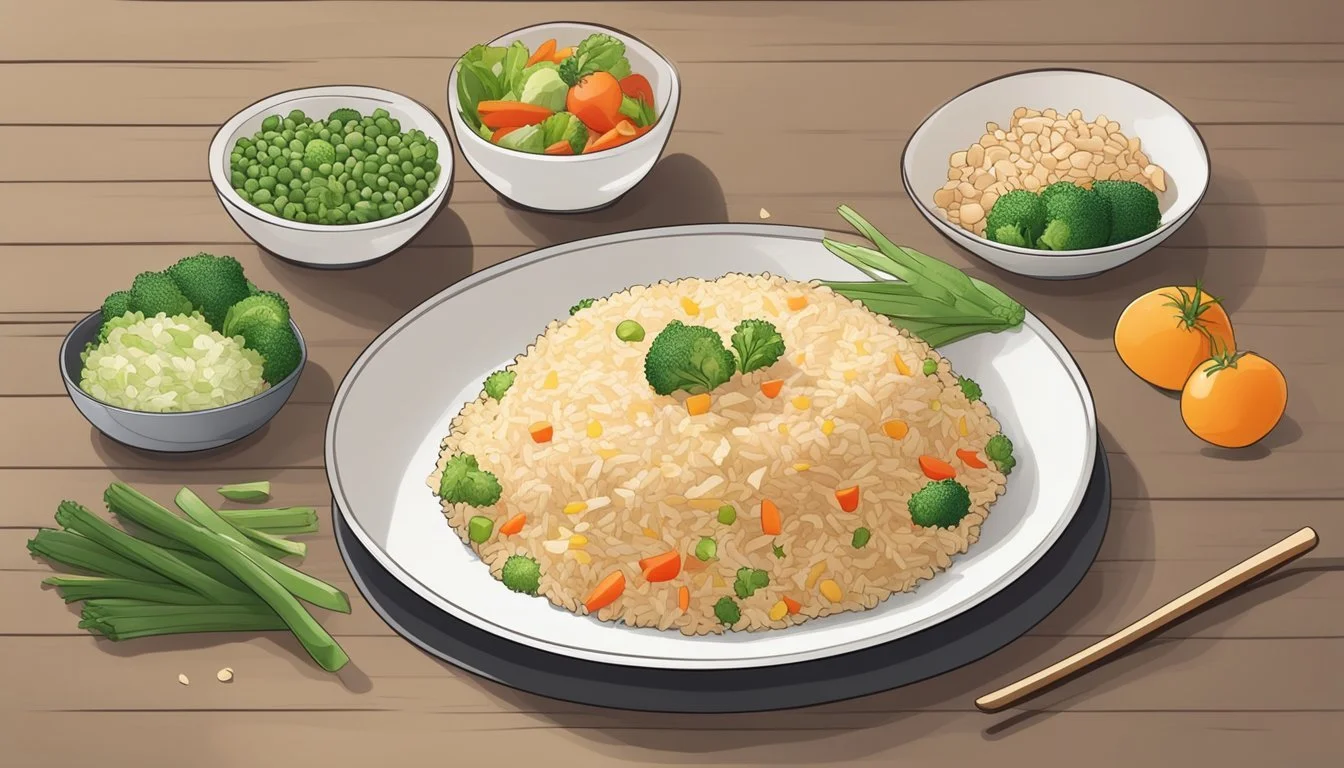How Long Does Gluten-Free Chicken Fried Rice Last?
Storage Tips Explained
Gluten-free chicken fried rice is a nutritious and versatile dish, perfect for those seeking a healthy meal option without compromising on flavor. It combines the wholesome goodness of vegetables, lean chicken, and flavor-packed seasonings, all brought together in a gluten-free recipe. This dish is not only delicious but also caters to those with gluten sensitivities or those simply looking to eat healthier.
Properly stored, gluten-free chicken fried rice can last in the refrigerator for up to 4-5 days. Ensuring it is kept in an airtight container helps maintain its freshness and flavor. Reheating leftover fried rice is simple, making it a convenient option for quick meals throughout the week. Whether reheated on the stove or in the microwave, a little patience and the right technique can bring the dish back to its original tasty state.
This gluten-free dish's nutrition information highlights its balance of protein, vegetables, and essential oils, making it an excellent choice for those mindful of their diet. Understanding how to store and reheat it properly not only preserves its nutritional value but also makes it a practical and enjoyable meal solution for busy lifestyles.
Understanding Gluten-Free Chicken Fried Rice
Gluten-free chicken fried rice is a popular dish that caters to those with gluten sensitivities and is made using specific ingredients to maintain its gluten-free status. It is both delicious and nutritious, offering several health benefits.
What Is Gluten-Free Chicken Fried Rice?
Gluten-free chicken fried rice is a variation of the traditional fried rice dish, specifically tailored for individuals who must avoid gluten. Key to its preparation is using ingredients such as gluten-free soy sauce or tamari to ensure no gluten is present.
It starts with cooked rice and typically includes diced chicken breast, eggs, and vegetables like green onions and snap peas. The dish is seasoned with gluten-free soy sauce or coconut aminos, sesame oil, and other spices.
Benefits of a Gluten-Free Diet
A gluten-free diet is essential for individuals with celiac disease or gluten intolerance. Removing gluten from the diet can lead to reduced gastrointestinal discomfort, improved nutrient absorption, and increased energy levels.
Eating gluten-free chicken fried rice allows those following this diet to still enjoy a popular meal without compromising their health. This meal also often incorporates nutrient-dense ingredients, which can support overall health and nutrition.
Key Ingredients for Gluten-Free Fried Rice
Rice: The base of the dish, usually pre-cooked and slightly dried out for the best texture.
Chicken: Commonly chicken breast, providing lean protein essential for muscle repair and growth.
Eggs: Scrambled and mixed into the rice for additional protein and flavor.
Vegetables: Typically green onions and snap peas, offering vitamins, minerals, and fiber.
Gluten-Free Soy Sauce or Tamari: Essential for flavor, making sure the dish remains gluten-free.
Sesame Oil: Used for cooking, adding a distinct nutty flavor.
Coconut Aminos: A soy-free alternative to soy sauce, suitable for those avoiding soy and gluten.
Each ingredient plays a crucial role in making sure the dish is not only safe for those with gluten sensitivities but also tasty and nutritious.
Preparation and Cooking Instructions
Creating gluten-free chicken fried rice involves selecting the best rice, employing effective preparation techniques, and utilizing proper cooking methods for delicious results. This section provides detailed guidelines on how to achieve the most flavorful and well-textured dish.
Choosing the Right Rice
Selecting the correct type of rice is crucial. Medium to long grain varieties work best, as they have a balance of starchiness that prevents clumping but still delivers a tender bite. Jasmine and Basmati rice are excellent choices.
Ensure the rice is fully cooked and cooled. For best results, cook the rice at least 2 hours ahead or the day before. Let it cool at room temperature before refrigerating. This drying-out process helps achieve the ideal texture.
Preparation Techniques
Begin by prepping all ingredients. Chop vegetables like peas, carrots, onions, and garlic. Slice two large chicken breasts into bite-sized pieces. Pre-cook the chicken in a non-stick skillet with a bit of oil and a dash of gluten-free soy sauce until lightly browned.
Whisk two eggs in a bowl. Scramble the eggs in a wok or large skillet over medium-high heat, then set them aside. For an extra touch, add a teaspoon of ghee while scrambling the eggs. Make sure all elements are prepared before starting the stir-fry process.
Cooking Methodology
Heat a large wok or skillet with a wide surface area over high heat. Add a tablespoon of vegetable oil once the cookware is hot. Next, quickly sauté garlic, ginger, and chillies for about 30 seconds.
Add the pre-cooked chicken and stir-fry until it achieves a golden color. Incorporate the cold rice, continuously stirring to evenly distribute heat and prevent sticking. This step should take about 2 minutes. Throw in the scrambled eggs and previously chopped vegetables.
Finally, season with gluten-free soy sauce, and toss everything together until evenly mixed and heated through. Adjust seasonings as per taste. Serve hot for the best experience.
Storage and Shelf Life
Gluten-free chicken fried rice can be stored effectively to maintain its freshness and flavor. Proper storage techniques and safety practices are crucial to extending its shelf life.
Storing Leftovers
Storing gluten-free chicken fried rice correctly begins with appropriate refrigeration. After cooking, allow the rice to cool to room temperature before transferring it to an airtight container. Storing the fried rice in the fridge at a temperature below 40°F (4°C) helps keep it fresh for 4 to 5 days.
If longer storage is needed, freeze the rice in portion-sized containers or freezer bags. Be sure to label these with the date, as frozen fried rice can be safely stored for up to 2 months.
Maximizing Freshness and Flavor
To maximize the freshness and flavor of gluten-free chicken fried rice, always use high-quality ingredients and ensure they are fresh before cooking. Once stored, reheating properly is essential. When reheating in the microwave, add a splash of water or broth to keep the rice moist. For stovetop reheating, a bit of oil or water helps revive the texture and flavor of the dish.
Avoid repeatedly reheating and cooling the rice, as this impacts both flavor and safety. Store and reheat only the portion you plan to consume immediately. This practice ensures that the remaining rice stays fresh for longer.
Safety Considerations
Safety is a key concern with leftover rice, including gluten-free chicken fried rice. Bacteria grow quickly at room temperature, so avoid leaving cooked rice out for more than 2 hours. When reheating, ensure the interior temperature reaches at least 165°F (74°C) to kill any potential bacteria.
Always check for signs of spoilage before consuming refrigerated fried rice. Look for changes in color, texture, or smell. If any spoilage signs are present, it’s best to discard the rice to avoid foodborne illnesses. Through proper storage and careful handling, gluten-free chicken fried rice can remain safe and enjoyable.
Enhancing and Customizing Your Dish
Enhancing and customizing your gluten-free chicken fried rice allows you to adapt it to various dietary preferences and flavor profiles. By choosing different proteins, vegetables, and seasonings, you can create a dish that suits your taste perfectly.
Additional Protein Options
Adding a variety of proteins to your gluten-free chicken fried rice makes it more versatile and satisfying. Beef and pork are great options for a richer flavor. If you prefer seafood, shrimp is a stellar choice that pairs well with soy sauce and sesame oil.
For a vegetarian option, use tofu or tempeh instead of chicken. Both provide a good source of protein and absorb the flavors of marinades and seasonings well. These substitutions make it easy to cater to different diets and preferences.
Variety of Vegetables
Vegetables add color, texture, and nutrients to your fried rice. Classic options include peas, carrots, and onions, which are staple ingredients in traditional recipes. To add more variety, consider broccoli, corn, and bell peppers. These vegetables blend well with the rice and provide additional vitamins and minerals.
For a touch of sweetness, stir in some corn kernels. Adding broccoli not only boosts the nutritional content but also adds a pleasant crunch. By mixing different vegetables, the dish becomes more interesting and nutritionally balanced.
Seasonings and Flavorings
The right seasonings and flavorings can elevate your gluten-free chicken fried rice. Soy sauce is a must for its umami depth, but for a soy-free option, consider using coconut aminos. Sesame oil adds a nutty aroma, while oyster sauce provides a savory sweetness.
To enhance the dish further, use fresh ginger and garlic. These ingredients offer robust flavors that complement the savory notes of the soy sauce and the richness of the sesame oil. Adjust the quantities of these seasonings to match your personal taste, making the dish truly customizable.
By experimenting with different proteins, vegetables, and seasonings, your fried rice can be tailored to meet a variety of dietary needs and flavor preferences, ensuring a delicious and satisfying meal every time.
Nutritional Profile and Health Benefits
Understanding the nutritional profile and health benefits of gluten-free chicken fried rice can help make informed dietary decisions. This dish is not only delicious but can also provide essential nutrients, making it a healthy meal option when prepared correctly.
Caloric and Macronutrient Breakdown
Gluten-free chicken fried rice can be a balanced meal with an appropriate mix of macronutrients. A typical serving contains:
Calories: Around 350-400 per serving.
Protein: Approximately 25-30 grams from chicken and eggs.
Carbohydrates: 45-50 grams from rice and vegetables.
Fats: 10-12 grams from cooking oils such as olive oil or sesame oil.
This profile provides energy and essential nutrients. Protein supports muscle maintenance and repair, while carbohydrates offer quick energy. Healthy fats from cooking oils are crucial for brain and heart health.
Micronutrients and Dietary Fiber
Gluten-free chicken fried rice also offers a range of important vitamins and minerals:
Vitamins: B vitamins from rice and chicken, Vitamin A from vegetables like carrots and peas.
Minerals: Iron from chicken, magnesium from rice, and potassium from vegetables.
Fiber Content: Typically includes 3-4 grams of dietary fiber, primarily from vegetables and rice.
Fiber aids digestion and keeps you feeling full longer. Together, these micronutrients contribute to overall health, supporting functions from energy metabolism to immune system health. When prepared with a variety of vegetables, this dish can become a nutrient-dense option.
Presentation and Serving Suggestions
When serving gluten-free chicken fried rice, presentation can make a significant difference. Consider using garnishes and plating techniques to enhance the appearance and overall dining experience.
Plating Techniques
Using small bowls or plates can help control portions and create an appealing look. Arrange the chicken fried rice in a neat mound and garnish with finely chopped spring onions or green onions for a pop of color.
A light sprinkle of sesame seeds adds texture and visual appeal. To elevate the dish further, add a wedge of lime on the side for a fresh, zesty option.
These touches make the meal inviting and aesthetically pleasing.






